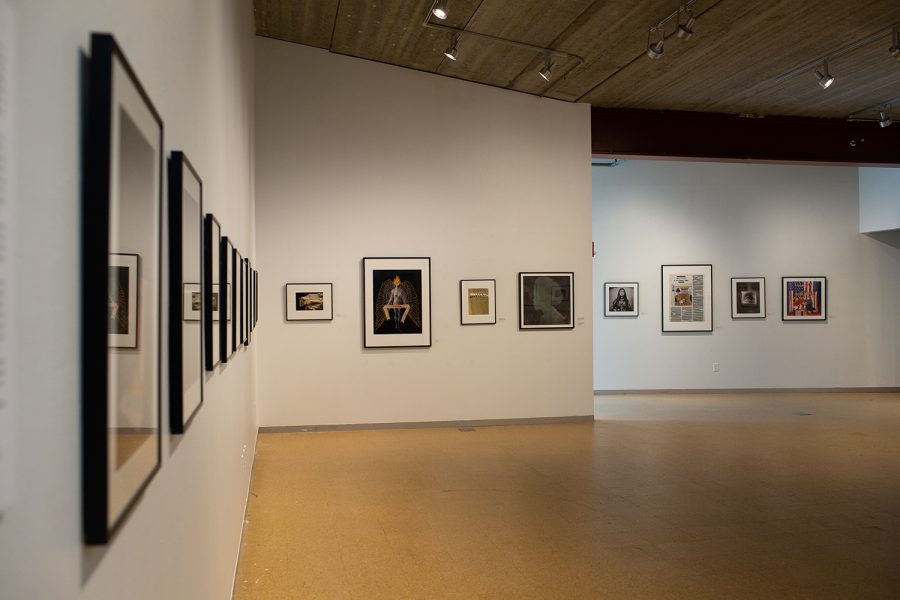‘A Yellow Rose Project’ brings centennial celebration of 19th Amendment to the UI
To celebrate the 100th anniversary of the 19th Amendment granting women the right to vote, ‘A Yellow Rose Project’ was created to bring together over 100 female photographers to design pieces on what the amendment means to them.
Photos that are a part of ‘A Yellow Rose Project’ are displayed in the Richard and Jeanne Levitt Gallery at the Art Building West in Iowa City on Sept. 12, 2022. ‘A Yellow Rose Project’ was created to celebrate the centennial anniversary of the 19th Amendment.
September 18, 2022
Shining through the front windows of Art Building West are the words A Yellow Rose Project, written in purple. Inside, 37 works from more than 100 women and female-identifying photographers hang on the gallery’s plain white walls. The silent space brings a loud sense of empowerment to those who visit — the pictures say everything without having to utter a word.
During the writing of the 19th Amendment in 1920, women would wear a yellow rose to signify their agreement with the women’s right to vote, and those in opposition would wear red. In 2019, in response to the amendment’s centennial anniversary, A Yellow Rose Project was created, and quickly spread across the country to celebrate the ratification.
If there’s one thing Co-Founder Frances Jakubek wants viewers to take away from the exhibit, it’s to vote.
Founding photographers Jakubek and Meg Griffiths began brainstorming the idea in 2019, wondering how they should select pictures and artists. They decided to pull from their own networks, both having either teaching or curatorial positions, along with their work in photography.
“Our main goal was to show a breadth of women’s experience in this country, what we deal with, between families and professions and rights or lack of rights or access,” Jakubek said. “What I feel is most important to take away is there’s a safe place to talk about things, which doesn’t always feel true in this country, or depends what state you’re in.”
From Boston University to Washington and Lee University, the 37 pieces now find themselves hanging in the Levitt Gallery of Art Building West at the University of Iowa until Sept. 30.
Rather than being a stationary gallery, Jakubek said they always knew they wanted it to be a web-based exhibit. The complete set of photos from every artist is available online, while the constantly shifting physical photography art has traveled throughout the country.
Related: UI’s ‘Borderless: An All Black Affair’ showcased artists and celebrated Black culture
Thalassa Raasch, a UI assistant professor of photography and experimental media, pitched the idea to bring A Yellow Rose Project to campus. As a participant in the project, Raasch felt bringing the exhibit to Iowa during the fall election cycle could be riveting.
“What we didn’t anticipate is that recently there’s been so many interesting political things unfolding over the summer, whether it’s overturning Roe v. Wade or other stories of voter suppression,” Raasch said. “It feels weirdly timely. We didn’t mean it to be that way.”
Photographers Amy Thompson Avishai and Serrah Russell both created pieces for the project, interpreting the centennial anniversary in their own ways.
Documentary and fine art photographer Avishai was inspired by a photo of a vote here sign in her hometown because it reminded her of her voting experiences.
When approached about commissioning a series of pieces for the project, Avishai thought back to when she voted in the 2018 midterm elections – when a record number of women ran for office. As a point, Avishai brings her daughters with her every time she votes to show them its importance.
“I usually go out of my way to do that. On this day, I didn’t have them,” Avishai said. “Ironically, that’s what probably allowed me the time to take the photo.”
The black and white photograph “Voting Day, Easthampton, Massachusetts” depicts a sign of the American flag with a rippled division down the center that’s covered in raindrops — or as Avishai sometimes sees it, covered in tears.
Russell also created a piece for the project, reflecting on the U.S.’ first ladies, and how though titled with a powerful position, they did not actually hold governmental power. When it came to crafting the photo, she referenced archived Vogue magazines realizing that every first lady has been featured at one point in the magazine.
“The way that these women get to be in the White House is like through marriage, through a wedding dress,” Russell said.
She played with digital tools to remove the image, leaving a silhouette, yet still left enough through the image and title to have audiences recognize who was in it. The title of her piece is taken from a quote in this “First Ladies” Vogue feature — “She knew how fragile things really were, and if she ever let go, even for a moment, all her plans might quickly unravel.”
The 19th Amendment was monumental to women in the U.S., and A Yellow Rose Project shows its power and longevity through the many artists’ thought-provoking photographs.



